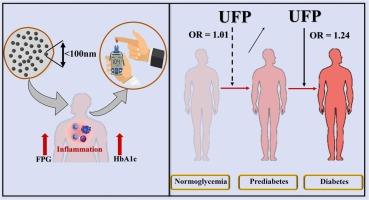长期暴露于超细粒子与 2 型糖尿病之间的关系:中国大规模多中心研究
IF 11.3
1区 环境科学与生态学
Q1 ENGINEERING, ENVIRONMENTAL
引用次数: 0
摘要
很少有研究探讨长期暴露于超细粒子(UFP)与2型糖尿病(T2DM)之间的关系。本研究旨在利用从2017年至2021年收集的大型多中心队列数据,调查长期暴露于超细粒子对糖尿病患病率和分期以及血糖指标的影响。评估的健康结果包括糖尿病患病率和分期(正常血糖、糖尿病前期和糖尿病),以及血糖指标,即空腹血糖(FPG)和糖化血红蛋白(HbA1c)。基线前三年的平均 UFP 浓度被用作长期 UFP 暴露水平。这项横断面研究包括 93,990 名参与者,糖尿病患病率为 10.97%。UFP在四分位数区间的增加与糖尿病患病率和分期有显著相关性,OR值分别为1.20(95% CI:1.14,1.26)和1.11(95% CI:1.07,1.44)。具体而言,正常血糖与糖尿病前期之间以及糖尿病前期与糖尿病之间的比较,相应的 OR 分别为 1.01(95% CI:0.96,1.04)和 1.24(95% CI:1.17,1.31)。UFP暴露与FPG和HbA1c水平升高也有明显相关性。这些研究结果表明,长期暴露于UFP可能是糖尿病的潜在风险因素,在糖尿病前期人群中风险更大。本文章由计算机程序翻译,如有差异,请以英文原文为准。

Associations between Long-term Exposure to Ultrafine Particles and Type 2 Diabetes: A Large-scale, Multicenter Study in China
Few studies have examined the associations between long-term exposure to ultrafine particles (UFP) and type 2 diabetes (T2DM). This study aimed to investigate the impact of long-term UFP exposure on diabetes prevalence and stages, as well as glycemic markers, using data from a large multi-center cohort collected from 2017 to 2021. The health outcomes assessed included diabetes prevalence and stages (normoglycemia, prediabetes, and diabetes), as well as glycemic markers, i.e., fasting blood glucose (FPG) and glycated hemoglobin (HbA1c). The three-year average UFP concentration prior to baseline was used as the long-term UFP exposure level. This cross-sectional study included 93,990 participants, with a diabetes prevalence of 10.97%. An interquartile range increase in UFP was significantly associated with diabetes prevalence and stages, with ORs of 1.20 (95% CI: 1.14, 1.26) and 1.11 (95% CI: 1.07, 1.44), respectively. Specifically, for comparison between normoglycemia and prediabetes, and between prediabetes and diabetes, the corresponding ORs were 1.01 (95% CI: 0.96, 1.04) and 1.24 (95% CI: 1.17, 1.31), respectively. UFP exposure was also significantly associated with elevated levels of FPG and HbA1c. These findings suggest that long-term UFP exposure may be a potential risk factor for diabetes with larger risks in the prediabetes population.
Data availability
Data will be made available on request.求助全文
通过发布文献求助,成功后即可免费获取论文全文。
去求助
来源期刊

Journal of Hazardous Materials
工程技术-工程:环境
CiteScore
25.40
自引率
5.90%
发文量
3059
审稿时长
58 days
期刊介绍:
The Journal of Hazardous Materials serves as a global platform for promoting cutting-edge research in the field of Environmental Science and Engineering. Our publication features a wide range of articles, including full-length research papers, review articles, and perspectives, with the aim of enhancing our understanding of the dangers and risks associated with various materials concerning public health and the environment. It is important to note that the term "environmental contaminants" refers specifically to substances that pose hazardous effects through contamination, while excluding those that do not have such impacts on the environment or human health. Moreover, we emphasize the distinction between wastes and hazardous materials in order to provide further clarity on the scope of the journal. We have a keen interest in exploring specific compounds and microbial agents that have adverse effects on the environment.
 求助内容:
求助内容: 应助结果提醒方式:
应助结果提醒方式:


